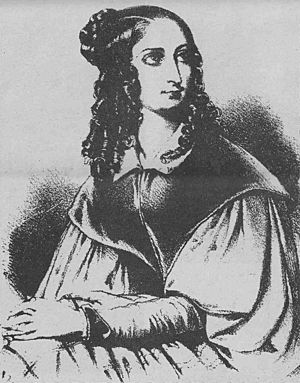Flora Tristan facts for kids
Flora Tristan (born Flore Celestine Thérèse Henriette Tristán y Moscoso on April 7, 1803 – died November 14, 1844) was a French-Peruvian writer and activist. She was a very early thinker in the world of socialism and feminist theory.
Flora believed that the progress of women's rights was directly connected to improving the lives of the working class. She wrote several important books. Some of her most famous works include Peregrinations of a Pariah (1838), Promenades in London (1840), and The Workers' Union (1843).
Did you know? Flora Tristan was also the grandmother of the famous painter Paul Gauguin.
Contents
Flora Tristan's Early Life
Flora Tristan's full name was Flore Celestine Thérèse Henriette Tristán y Moscoso. Her father, Mariano Eusebio Antonio Tristán y Moscoso, was a colonel in the Spanish Navy. He was from Arequipa, a city in Peru. His family was very powerful in southern Peru. Flora's uncle, Pío de Tristán, even became a viceroy of Peru.
Flora's mother, Anne-Pierre Laisnay, was French. Her parents met in Bilbao, Spain. When Flora's father died in 1807, before her fifth birthday, her family's life changed a lot. They lost their high standard of living.
In 1833, Flora traveled to Arequipa, Peru. She wanted to claim her father's inheritance, which was with her uncle, Juan Pío de Tristán y Moscoso. She stayed in Peru until July 16, 1834. Even though she didn't get the inheritance, she wrote a travel diary about her experiences. This diary was published in 1838 as Pérégrinations d'une paria.
Her Big Ideas: Helping Workers and Women
Flora Tristan wrote an important essay called The Workers' Union in 1843. She wrote it after spending time in Peru and a short trip to Britain. This book made her known as a political activist.
In this work, Flora Tristan shared ideas similar to other early socialists like Charles Fourier. She also studied the ideas of the Saint Simonians. But Flora went further. She created a different solution for the problems faced by working people, especially working women. She was the first to say that the freedom of the working class was linked to women gaining more rights.
Flora saw that working people had been struggling for a long time without success. Her idea was for them to create a "Workers' Union." She believed this would make them strong. She wrote, "divided, you are weak... Union makes power." She suggested that money from union members could help build safe places and schools for children of workers. It could also build hospitals for sick and injured workers. She also wanted to reach out to wealthy people to help support these programs.
Flora Tristan strongly believed that women needed to be free for the working class to truly be free. She argued that if society fixed the unfairness towards women, everything else would improve. She thought that helping women would benefit the most people.
She knew that after the French Revolution, women were not easily seen as equal. So, she explained how women's liberation would help men too. Flora was the first to connect the growing movement for social rights with the idea of women's freedom. This laid the foundation for what we now call feminism.
Flora Tristan made a powerful comparison. She said that the most oppressed man still has someone to oppress: his wife. She called the wife "the proletarian of the proletarian." This means that even the poorest man could still control his wife. She believed that women, like the working class, would eventually have their own "1789" (referring to the French Revolution).
Flora's efforts to create a common union ended when she died young from typhoid fever in 1844. She built on the ideas of other socialists to create a practical plan. She changed the approach by including women's rights as a key part of creating an independent Workers' Union.
Why Flora Tristan Was Important
Flora Tristan's writings showed that women could think deeply about freedom. She combined the struggle for women's rights with the ideas of socialism. Because of this, Flora Tristan is known as the "mother of feminism and of popular communitarian socialism." She fought against the unfairness and prejudice that kept women down.
Flora helped organize the scattered ideas about women's equality that came from the French Revolution. She set the stage for the rise of feminism later in the 1800s. She died "defending the rights of the proletarian... whilst preaching... the law of union and love."
Flora Tristan was the first woman to try to combine feminist ideas with social ideas. She opened the way for a type of feminism that understood how working-class women could also be oppressed by other women.
She highlighted ideas that put workers' rights first. She was the first to suggest that freeing the working class would be the result of people fighting against the wealthy class. She added that this could only happen if men and women were both freed.
Flora Tristan's life and work have been very important for understanding women's contributions throughout history. She helped establish histories that focus on the role of women.
Her Legacy and Recognition
Flora Tristan is still remembered today.
The writer Mario Vargas Llosa wrote a historical novel in 2003 called The Way to Paradise. It explores Flora Tristan's life and her grandson Paul Gauguin's search for an ideal life.
In Paris, France, there is a place called Place Flora Tristan. It has a sign describing her as a "Femme de Lettres" (woman of letters) and "Militante Féministe" (feminist activist).
The Centre Flora Tristan in Châtillon is a safe place for women. A nursery school in Orléans (Ecole Maternelle Flora Tristan) and a secondary school in Noisy-le-Grand (Lycee Flora Tristan) are also named after her.
The Flora Tristán Peruvian Women's Center is a non-governmental organization in Peru named in her honor.
See also
 In Spanish: Flora Tristan para niños
In Spanish: Flora Tristan para niños


